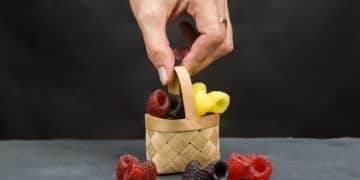Reduce Sugar Intake by 25% in 30 Days: A Step-by-Step Plan

Achieving a 25% reduction in sugar intake within 30 days is a realistic goal, primarily by identifying hidden sugars, making conscious food choices, and implementing gradual lifestyle changes, ultimately improving overall health and well-being.
Embarking on a journey to reduce sugar consumption can feel daunting, yet it’s one of the most impactful steps you can take for your health. This comprehensive guide will show you How to Reduce Sugar Intake by 25% in 30 Days: A Step-by-Step Plan, offering actionable strategies and insights to make this vital shift manageable and sustainable. Prepare to explore practical approaches that empower you to regain control over your diet and enhance your well-being.
understanding the hidden sugars in your diet
Understanding where added sugars lurk in our daily diets is the crucial first step toward effective reduction. It’s not just the obvious culprits like sodas and candies; many processed foods, seemingly healthy options, and even savory dishes contain significant amounts of sugar. This awareness empowers you to make informed decisions and begin your journey towards a healthier eating pattern.
Examining food labels meticulously is paramount. Sugar, sucrose, high-fructose corn syrup, dextrose, maltose, and corn syrup are just a few of the many names manufacturers use to disguise added sugars. The general rule of thumb is that if an ingredient ends in “ose,” it’s likely a sugar. Moreover, understanding serving sizes helps interpret the total sugar content more accurately. A product might seem low in sugar per serving, but if you consume multiple servings, the sugar intake quickly escalates.
deciphering food labels and ingredients
The task of deciphering food labels can be confusing, given the myriad of names for sugar. Food companies are adept at making their products appealing, often by adding sugar to enhance flavor and shelf life. Learning to spot these hidden sugars transforms you into a more discerning consumer.
* Look for “added sugars” on the nutrition facts panel: The FDA now requires food labels to differentiate between naturally occurring sugars (like those in fruit) and added sugars. This is a game-changer for tracking your intake.
* Check the ingredients list: Ingredients are listed in descending order by weight. If sugar or one of its many aliases appears near the top, that product likely has a high sugar content.
* Be wary of “healthy” marketing claims: Terms like “natural,” “organic,” or “gluten-free” don’t automatically mean low sugar. Always check the nutrition facts.
common sources of hidden sugar
Beyond the usual suspects, numerous foods commonly found in our pantries and refrigerators are sugar traps. Recognizing these sources allows for targeted modifications in your diet.
* Yogurt: Many flavored yogurts, even those marketed as healthy, can contain as much sugar as a dessert. Opt for plain, unsweetened varieties and add your own fresh fruit.
* Sauces and dressings: Ketchup, BBQ sauce, salad dressings, and marinades often have surprisingly high sugar content. Read labels carefully or make your own.
* Breakfast cereals and granola bars: These convenient options are frequently loaded with added sugars, contributing significantly to your daily intake from the start of the day.
* Bread: Even savory breads can contain added sugar to improve texture and shelf life. Choose options with minimal or no added sugar.
Identifying and understanding hidden sugars is the bedrock of reducing your intake. It empowers you to be an active participant in your dietary choices, paving the way for healthier habits. Armed with this knowledge, you are better equipped to navigate the supermarket aisles and select foods that truly nourish your body without unnecessary sugar. This conscious approach is fundamental to achieving your 25% reduction goal.
gradual reduction strategies for sustained success
Embarking on a sugar reduction journey requires a strategic, gradual approach for long-term success. Abrupt changes can often lead to intense cravings and eventual relapse. The goal is to slowly modify your palate and habits, making the transition less burdensome and more sustainable. This section delves into practical methods for incrementally cutting down on sugar, allowing your body and taste buds to adjust naturally.
One cannot simply eliminate all sugar overnight without experiencing significant withdrawal symptoms, which include intense cravings, headaches, and irritability. These symptoms can derail even the most determined individual. Instead, focus on small, consistent reductions that accumulate over time, making the change feel less like a deprivation and more like a gentle evolution of your eating habits. This careful tapering allows your taste receptors to reset, appreciating the natural sweetness of foods more acutely.
week-by-week sugar reduction plan
Implementing a structured, week-by-week plan can provide a clear roadmap for your 30-day sugar reduction goal. Each week, focus on eliminating or reducing certain sugar sources, building upon the previous week’s efforts.
* Week 1: Tackle sugary drinks. This is often the easiest and most impactful first step. Replace sodas, sweetened teas, and fruit juices with water, sparkling water with a splash of lime, or unsweetened herbal tea.
* Week 2: Be mindful of breakfast sugars. Many breakfast cereals, instant oatmeals, and pastries are sugar bombs. Switch to plain oatmeal with berries, eggs, or unsweetened Greek yogurt.
* Week 3: Address hidden sugars in sauces and condiments. Scrutinize labels on ketchup, BBQ sauce, salad dressings, and marinades. Opt for sugar-free versions or make your own from scratch.
* Week 4: Reduce dessert and snack sugars. Instead of processed pastries or candy, choose fresh fruit, a small handful of nuts, or a piece of dark chocolate (70% cocoa or higher) for a treat.
practical tips for cutting back without feeling deprived
The perception of deprivation is a major hurdle in any dietary change. The key is to find satisfying alternatives and tricks that make reducing sugar feel less like a sacrifice and more like a discovery of new, delicious ways to eat.
* Read labels religiously: As discussed, becoming an expert label reader empowers you to make informed decisions and avoid hidden sugars.
* Cook more at home: When you prepare your own meals, you have complete control over the ingredients, including how much sugar goes into your food.
* Embrace natural sweetness: Incorporate more fruits into your diet. Their natural sugars, combined with fiber, provide a satisfying sweetness without the sudden blood sugar spikes. Dates, berries, and apples can be great substitutes for sugary snacks.
* Spice it up: Use spices like cinnamon, nutmeg, and vanilla extract to add flavor and a perception of sweetness to foods without adding sugar. These are excellent in oatmeal, coffee, or even plain yogurt.
* Stay hydrated: Sometimes, thirst can be mistaken for hunger or a craving for something sweet. Drinking plenty of water throughout the day can help manage cravings.

The journey to reduce sugar intake is not about perfection, but about progress. By adopting these gradual reduction strategies and embracing practical tips, you can successfully lower your sugar consumption by 25% within 30 days. This methodical approach ensures that the changes are lasting, leading to improved health and a refined palate that genuinely appreciates natural, wholesome flavors.
smart swaps and healthy alternatives
Successfully reducing sugar intake by 25% within 30 days heavily relies on making smart substitutions in your daily diet. This isn’t about eliminating sweetness entirely, but rather about replacing refined, added sugars with healthier alternatives that offer nutritional benefits without the detrimental health effects. The focus shifts from processed, empty calories to nutrient-dense options that satisfy cravings naturally.
The market is flooded with products that claim to be “sugar-free” but often contain artificial sweeteners, which may have their own set of health concerns. The truly smart approach is to pivot towards whole, unprocessed foods that are intrinsically low in added sugar or possess natural sweetness from sources like whole fruits. This involves rethinking your common food choices and consciously seeking out better ingredients.
replacing sugary beverages and snacks
Sugary drinks and snacks are often the largest contributors to excess sugar intake. They provide quick bursts of energy followed by crashes, leading to a cycle of cravings. Replacing them with wiser choices can significantly impact your 30-day goal.
* Hydration first: Instead of soda, juice, or sweetened coffee/tea, make water your primary beverage. Infuse it with cucumber, mint, lemon, or berries for a refreshing twist.
* Homemade is best: Prepare your own iced tea (unsweetened), coffee (black or with a splash of unsweetened milk), or smoothies (using whole fruits and vegetables, no added sugar).
* Smart snack choices: Swap sugary granola bars, cookies, and chips for fresh fruit, a handful of unsalted nuts, plain yogurt with berries, vegetable sticks with hummus, or hard-boiled eggs. These provide fiber, protein, and healthy fats that promote satiety.
healthier alternatives for common high-sugar foods
Many staple foods in our diets are surprisingly high in sugar. Identifying these and finding suitable alternatives is crucial.
* Breakfast cereals: Ditch the sugary boxed cereals. Opt for rolled oats sweetened with fresh fruit, a sprinkle of cinnamon, and a few nuts. Whole-wheat toast with avocado or eggs is another excellent choice.
* Sauces and dressings: Store-bought options are often loaded with sugar. Make your own salad dressings with olive oil, vinegar, herbs, and spices. Choose mustard over ketchup or find a sugar-free brand. For stir-fries, use low-sodium soy sauce or tamari without added sweeteners.
* Yogurt options: Flavored yogurts are notorious sugar bombs. Buy plain, unsweetened Greek yogurt and add your own fresh fruit, a drizzle of pure maple syrup or honey (sparingly, in line with your 25% reduction goal), and a sprinkle of chia seeds.
* Desserts: Instead of cakes, cookies, and ice cream, enjoy fresh fruit, baked apples with cinnamon, or a small piece of high-quality dark chocolate (70% cacao or higher). For a creamy treat, blend frozen bananas into “nice cream.”
Implementing these smart swaps requires preparation and a willingness to explore new culinary avenues. The initial adjustment might feel challenging, but as your taste buds adapt, you’ll begin to appreciate the natural flavors of food more fully. This transition not only aids in sugar reduction but also opens the door to a more varied and nutrient-rich diet, ultimately contributing to better overall health and well-being beyond the 30-day mark.
managing cravings and emotional eating
One of the most persistent challenges in reducing sugar intake is managing cravings and addressing emotional eating patterns. Sugar can be highly addictive, triggering dopamine releases that create a sensation of pleasure, leading to a strong desire for more. Furthermore, many individuals turn to sugary foods as a coping mechanism for stress, boredom, or sadness. Overcoming these deeply ingrained habits is vital for sustained success in your 30-day sugar reduction plan.
Successfully navigating cravings doesn’t mean willpower alone. It requires understanding the triggers, developing coping strategies, and finding alternative ways to satisfy emotional needs without resorting to sugar. This journey involves both physical adaptation as your body adjusts to less sugar and psychological work to break the cycle of emotional eating.
strategies to curb sugar cravings
Cravings are a natural part of weaning off sugar, but they don’t have to control you. Implementing specific strategies can help mitigate their intensity and frequency.
* Stay hydrated: Often, what we perceive as a craving for sugar is actually dehydration. Drink a large glass of water and wait 10-15 minutes to see if the craving subsides.
* Choose protein and fiber: Meals and snacks rich in protein and fiber help stabilize blood sugar levels, preventing the dips that often trigger sugar cravings. Think nuts, seeds, lean meats, beans, and whole grains.
* Distract yourself: When a craving strikes, engage in an activity that takes your mind off food. Call a friend, go for a walk, read a book, or engage in a hobby.
* Allow a small, healthy treat: If the craving is intense, opt for a small piece of dark chocolate, a handful of berries, or a baked apple. This can satisfy the desire for sweetness without derailing your entire plan.
identifying and addressing emotional triggers for eating sugar
Emotional eating is a complex habit, often developed over years. Recognizing the specific emotions or situations that lead you to sugar is the first step in breaking the cycle.
* Keep a food and mood journal: For a few days, record not just what you eat, but also how you feel before and after eating, particularly when consuming sugary foods. Look for patterns related to stress, boredom, anxiety, or fatigue.
* Find non-food coping mechanisms: Once you identify your emotional triggers, brainstorm healthier ways to address those feelings. If you eat when stressed, try meditation, deep breathing exercises, or a calming walk. If you eat when bored, find a new hobby or activity.
* Seek support: Talk to a trusted friend, family member, or a professional like a therapist or nutritionist. Sharing your struggles can provide perspective and accountability.
* Practice mindful eating: When you do eat, slow down. Pay attention to the flavors, textures, and aromas. This can help you recognize true hunger versus emotional hunger and find greater satisfaction from your food without excess sugar.
Managing cravings and emotional eating requires patience and self-compassion. It’s a process of unlearning old habits and building new, healthier ones. By understanding your triggers, having a toolkit of coping strategies, and practicing self-awareness, you can effectively navigate these challenges and make significant strides in reducing your sugar intake for a healthier, more balanced life.
hydration and gut health: allies in your sugar reduction journey
Beyond simply cutting back on sugary foods, optimizing your body’s internal environment plays a critical role in your success to reduce sugar intake. Proper hydration and a healthy gut microbiome are powerful allies in this journey, directly influencing your energy levels, cravings, and metabolism. Focusing on these two areas can significantly ease the transition away from high sugar consumption and bolster your overall well-being.
Many people underestimate the profound impact water intake has on satiety and the subtle signals of hunger. Often, thirst is mistaken for hunger, leading to unnecessary snacking or reaching for sugary comfort foods. Similarly, a healthy gut contributes to stable blood sugar levels and can even influence cravings, making it easier to stick to your dietary goals. By prioritizing hydration and nurturing your gut, you create a more resilient system less prone to sugar dependency.
the role of proper hydration in managing sugar intake
Adequate water intake is a simple yet powerful tool in your sugar reduction arsenal. It goes beyond just keeping you hydrated; it actively participates in regulating various bodily functions that impact sugar cravings.
* Satiety and appetite control: Drinking water before meals can help you feel fuller, leading to reduced overall food intake, including sugary items. It also helps distinguish genuine hunger from thirst.
* Metabolic function: Water is essential for every metabolic process, including the breakdown of glucose for energy. Proper hydration ensures your metabolism runs efficiently, potentially reducing cravings for quick energy fixes from sugar.
* Detoxification: Water aids your kidneys in flushing out waste products and excess glucose, supporting your body’s natural detoxification processes and preventing lethargy that might otherwise lead to sugar seeking.
* Energy levels: Dehydration can cause fatigue, which often prompts a search for sugary pick-me-ups. Staying well-hydrated keeps energy stable throughout the day, minimizing the need for artificial boosts.
nurturing your gut microbiome for reduced cravings
Emerging research highlights the fascinating connection between gut health and sugar cravings. Your gut microbiome—the trillions of bacteria living in your intestines—plays a significant role in your mood, metabolism, and even what foods you crave. An imbalanced gut can contribute to increased sugar desires.
* Incorporate probiotics: Consume probiotic-rich foods like plain, unsweetened yogurt, kefir, sauerkraut, kimchi, and kombucha. These introduce beneficial bacteria that can help crowd out sugar-loving microbes.
* Increase prebiotic fiber: Prebiotics are non-digestible fibers that feed good gut bacteria. Excellent sources include garlic, onions, leeks, asparagus, bananas, and oats. A diverse intake of fiber promotes a healthy, balanced gut.
* Limit artificial sweeteners: While seemingly a solution, some artificial sweeteners can negatively impact the gut microbiome, potentially leading to increased sugar cravings in the long run. Focus on natural, whole-food sweetness instead.
* Reduce processed foods: Processed foods, often high in sugar and unhealthy fats, can disrupt gut balance. Prioritizing whole, unprocessed foods supports a thriving and diverse gut microbiome.
By consciously integrating optimal hydration and gut-supportive foods into your daily routine, you set the stage for a more successful and less challenging sugar reduction journey. These fundamental aspects of health don’t just help you cut sugar; they contribute to a profound improvement in overall vitality and well-being, paving the way for lasting healthy habits.
meal planning and preparation for success
Successful sugar reduction, particularly aiming for a 25% decrease in 30 days, is significantly bolstered by proactive meal planning and meticulous food preparation. Relying on last-minute decisions or pre-packaged convenience foods often leads to higher sugar consumption, as these options frequently contain hidden sugars and less nutritional value. Strategic planning transforms your approach from reactive to proactive, ensuring you have healthy, low-sugar options readily available.
The absence of a plan can easily lead to succumbing to cravings or making suboptimal food choices when hunger strikes. By dedicating time to thoughtful meal planning and batch cooking, you eliminate guesswork and build a supportive environment for your sugar-reduction goals. This structured approach helps maintain consistency, control ingredients, and ultimately, achieve your desired results.
creating a low-sugar meal plan for 30 days
Designing a meal plan focused on low-sugar options is a cornerstone of this 30-day challenge. It requires identifying suitable recipes, shopping smart, and envisioning your meals for the week or month ahead.
* Assess your current intake: Before planning, spend a few days tracking your typical sugar intake to understand your starting point. This helps identify key areas for reduction.
* Build around whole foods: Prioritize lean proteins (chicken, fish, eggs, legumes), healthy fats (avocado, nuts, seeds, olive oil), complex carbohydrates (whole grains like quinoa, brown rice, oats), and plenty of non-starchy vegetables.
* Breakfast ideas: Opt for unsweetened oatmeal with berries and nuts, scrambled eggs with vegetables, or plain Greek yogurt with cinnamon and a small amount of fruit.
* Lunch and dinner strategies: Focus on balanced meals like grilled chicken or fish with a large serving of steamed vegetables, a hearty salad with homemade dressing, or a lentil soup. Incorporate dishes that naturally have low sugar content.
* Snack intelligently: Pre-portion snacks like a handful of almonds, apple slices with peanut butter (check for no added sugar), or vegetable sticks with hummus.
batch cooking and smart grocery shopping
Efficient meal preparation and wise grocery shopping are powerful tools that complement your meal plan, making healthy eating convenient and accessible.
* Batch cook staples: Dedicate a few hours one day a week (e.g., Sunday) to prepare foundational items. Cook a large batch of grains (quinoa, brown rice), roast a tray of vegetables, grill chicken breasts, or prepare a big pot of sugar-free soup or chili. These can be easily assembled into various meals throughout the week.
* Pre-cut and portion: Wash and chop vegetables right after grocery shopping. Portion out nuts, seeds, or plain yogurt into individual containers for quick grabs when hunger strikes.
* Create a detailed grocery list: Based on your meal plan, make a comprehensive list. Stick to the perimeter of the grocery store where fresh produce, meats, and dairy are typically found, as processed items often reside in the inner aisles.
* Read labels at the store: Even with a plan, take a moment to double-check labels for hidden sugars in unexpected items like bread, sauces, or canned goods.
* Don’t shop hungry: Shopping on an empty stomach increases the likelihood of impulse buys, especially sugary or processed items. Eat a healthy snack before heading to the store.
By implementing robust meal planning and efficient preparation strategies, you significantly reduce the chances of falling back into old habits. This foresight not only saves time and money but also empowers you to stay in control of your sugar intake, making the 25% reduction goal within 30 days an attainable and sustainable reality.
maintaining progress and long-term habits
Achieving a 25% reduction in sugar intake within 30 days is a significant accomplishment, but the true measure of success lies in maintaining this progress and transforming temporary changes into sustainable, long-term habits. The initial 30 days lay the groundwork, allowing your taste buds to adapt and your body to begin experiencing the benefits of reduced sugar. The subsequent challenge is to solidify these gains and make them an ingrained part of your lifestyle, preventing relapse and ensuring continued health improvements.
Sustainability hinges on flexibility, self-compassion, and an ongoing commitment to mindful eating. It’s not about perfect adherence every single day, but rather about developing a resilient approach that allows for occasional indulgences while keeping your overall sugar intake low and your health goals in sight. The aim is to cultivate a healthy relationship with food, free from the grips of sugar addiction.
strategies for sustainable sugar reduction
To prevent a regression to old habits, integrate strategies that support a low-sugar lifestyle for the long haul. This involves conscious decisions and continuous learning about your body’s needs.
* Celebrate small victories: Acknowledge your progress throughout the 30 days and beyond. Celebrating motivates you to continue and reinforces positive behavior.
* Educate yourself continuously: Stay informed about nutrition, the impact of sugar, and new research. The more you understand, the more empowered you feel to make healthy choices.
* Find your favorite healthy treats: Discover healthier alternatives that you genuinely enjoy. This prevents feelings of deprivation and makes the low-sugar lifestyle more appealing. Dark chocolate, fruit and nut combinations, or homemade sugar-free desserts can be satisfying.
* Listen to your body: Pay attention to how different foods make you feel. Notice the increased energy, better sleep, and fewer cravings that come with reduced sugar. These positive reinforcements are powerful motivators.
* Be prepared for social situations: Dining out or attending gatherings can be challenging. Plan ahead by checking menus online, offering to bring a healthy dish, or politely declining sugary options.
overcoming plateaus and occasional slips
The journey towards sustained health is rarely linear. Plateaus and occasional slips are inevitable, but how you respond to them determines your long-term success.
* Don’t let perfection be the enemy of good: One slip does not undo your progress. If you indulge in a sugary treat, acknowledge it without guilt, and then get right back on track with your next meal.
* Re-evaluate and adjust: If you hit a plateau or find yourself struggling, reassess your strategies. Are there new hidden sugar sources creeping in? Are you managing stress effectively? Sometimes, minor adjustments can make a big difference.
* Revisit your “why”: Remind yourself of the reasons you started this journey – better health, more energy, stable moods, clear skin. Reconnecting with your core motivation can reignite determination.
* Seek accountability: Share your goals with a supportive friend or family member, or consider joining a health group. External accountability can be a powerful motivator.
* Focus on overall dietary patterns: Shift your perspective from individual food items to your overall eating pattern. A balanced diet rich in whole, unprocessed foods, even with minor deviations, is far more effective than an inconsistent strict adherence.
By embracing these strategies for maintaining progress and gracefully navigating challenges, you can ensure that your initial 25% sugar reduction in 30 days becomes a starting point for a lifetime of healthier eating habits. This long-term commitment to a low-sugar lifestyle will unlock sustained improvements in your energy, mood, weight management, and overall vitality, allowing you to live a fuller, healthier life.
| Key Point | Brief Description |
|---|---|
| 🔍 Identify Hidden Sugars | Learn to read food labels and recognize the many names for added sugar in processed foods. |
| 🏃 Gradual Reduction | Implement a week-by-week plan to slowly cut down on sugary drinks, breakfasts, and snacks to avoid withdrawal. |
| 🍎 Smart Swaps | Replace high-sugar items with healthier alternatives like water, whole fruits, nuts, and homemade sauces. |
| 🧘 Manage Cravings | Stay hydrated, prioritize protein/fiber, and identify emotional triggers to avoid relying on sugar for solace. |
frequently asked questions about sugar reduction
Reducing added sugar by 25% over 30 days is generally safe and beneficial. This plan focuses on gradual reduction and replacing added sugars with whole foods, not eliminating all natural sugars from fruits and vegetables. It’s a moderate and achievable goal aimed at improving overall health without adverse effects, especially if you focus on processed sugars.
Common withdrawal symptoms can include headaches, fatigue, irritability, difficulty concentrating, and intense cravings for sugary foods. These symptoms usually peak within the first few days and gradually subside as your body adjusts to lower sugar intake. Staying hydrated and consuming nutrient-dense foods can help mitigate these effects.
Absolutely. Fruits contain natural sugars, but they also provide essential fiber, vitamins, and antioxidants. The fiber in whole fruits helps slow down sugar absorption, preventing rapid blood sugar spikes. The focus of this plan is on reducing added sugars found in processed foods, not the natural sugars in whole fruits.
Look beyond “sugar” on ingredients lists. Common aliases include high-fructose corn syrup, corn syrup, dextrose, maltose, sucrose, glucose, fructose, agave nectar, maple syrup, honey, and fruit juice concentrate. If any of these are listed high up on the ingredient list, the product likely contains a significant amount of added sugar.
Slips are a normal part of any dietary change. Don’t let one instance derail your entire effort. Acknowledge it, learn from it, and immediately get back on track with your next meal or snack. The goal is progress, not perfection. Focus on your overall consistency rather than isolated incidents.

conclusion
Embarking on the journey to reduce your sugar intake by 25% in just 30 days is a powerful commitment to your health and well-being. This step-by-step plan, anchored in awareness, gradual changes, smart substitutions, and self-management, offers a clear path to achieve this goal effectively and sustainably. By understanding where hidden sugars lie, nurturing your body through hydration and gut health, and proactively planning your meals, you are not merely cutting out a food group; you are cultivating a more mindful and balanced relationship with your diet. The initial 30 days serve as a transformative period that will likely lead to increased energy, stable moods, and a more refined palate that truly appreciates natural flavors. Remember that consistency, not perfection, is key, and every small step you take contributes to a healthier, more vibrant you.





